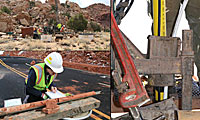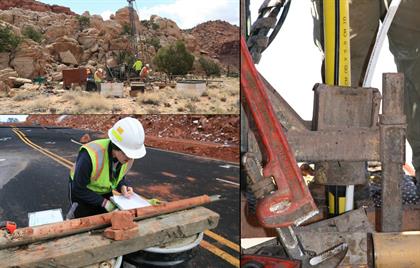Geotechnical section plays important role in roadway and structural design
Geotechnical section plays important role in roadway and structural design

Above are some images of the geotechnical work happening on US 89. ADOT's geotechnical experts are responsible for much more besides the work on US 89
We know you...
You’ve been following our US 89 videos and blog posts since the landslide occurred back in February.
You know all about the geotechnical investigation happening at the site – by now, you’re practically an expert.
You also are aware that the work being performed now will help ADOT determine the best next steps for restoring the route.
You’re even well versed in some of the terminology ... words like extensometer, inclinometer, LiDar, DTM and TDR actually make sense.
Now, if we know you like we think we do, right about now you might be wondering what ADOT’s geotechnical experts do when there isn’t something like a major landslide to contend with.
Are we right?
Hope so, because that’s the subject of this post!
Typical projects
ADOT’s geotechnical section plays a very important role in roadway and structural design.
When it comes to a “typical project,” like say a roadway widening, the geotechnical experts are in on the process early on.
It all starts with a project assessment and a look at preliminary plans – this gives the geotechnical group an idea of the project’s scope.
The team will use those preliminary plans to develop an investigation plan. Going by established geotechnical guidelines, the experts will decide where to dig for soil samples, at what intervals and how many samples to get.
Next, the geotechnical investigation plan goes to ADOT’s environmental group for clearance. Once the plan is approved, crews will go out to the field and mark where they’re planning to dig. Arizona Blue Stake is then notified and any underground facility owners (water, gas, electrical) will make sure there are no conflicts.
After that, crews start digging... and digging (pits are typically five-feet deep).
The soil samples are brought to a soils and aggregate lab so the properties of the soil can be determined.
The analysis tells the geotechnical experts quite a bit, according to ADOT Transportation Engineering Specialist Dhan Harnanan.
He explains that by understanding the type of soil at the site – including its density, moisture content and strength – his team can make recommendations to pavement designers.
Basically, if the soil isn’t ideal, designers might have to look at using a thicker pavement. If the soil is really unsuitable, the geotechnical section might recommend building up that support base with additional material or even call for the replacement of the soil with something better for building.
But, wait ... that’s not all
Not all projects are as typical as what’s described above. The geotechnical group works closely with and provides technical assistance to the engineering districts and other ADOT sections on other issues on the state highway system, including but not limited to culvert issues (collapse, scour etc), embankment settlements, slope failures and yes, landslides. The group also assists the engineering districts with any geotechnical aspects of projects for inclusion in the Five-Year Construction Program.
In addition to performing engineering analyses and writing design reports, the group is also responsible for reviewing investigations, reports, and other geotechnical documents prepared by consultants or other government agencies.
In addition to that, the group annually surveys sites within the state highway system for areas of potential rockfall.
“The sites are assigned ratings. Typically the highest rated sites are identified for rockfall mitigation projects to be programmed and included in the Highway Construction Program,” Harnanan said.
The geotechnical group also works closely with the pavement design group in reviewing their Materials Design Reports generated for either pavement rehabilitation or new pavement construction.
Preparation of specifications for the geotechnical aspects of projects is another responsibility of the group.
By the way, this by far isn’t an exhaustive list of what the section is responsible for, but hopefully it gives you a basic idea of what the team does.
The importance of the geotechnical group
Safety and the longevity of the road or structure are the overriding goals for the geotechnical group.
And those two factors depend very much on knowing how the land/dirt/rocks/soil will behave.
“If we don’t do all of this, then nobody really has an idea of what they’re building on,” Harnanan said.
Learn more about the geotechnical section by visiting ADOT’s website.

